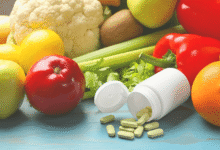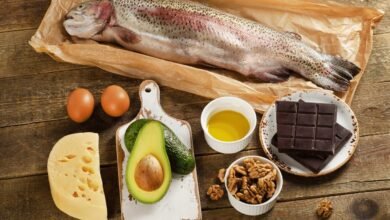How to Lose Fat and Gain Muscle at the Same Time

Body recomposition is the process of simultaneously gaining muscle and losing fat. It is not an easy process to carry out, though, because these two objectives are physiologically contradictory; as such, your body may resist doing them both at the same time, especially if your main objective is weight loss.
The Best Way to Lose Fat and Gain Muscle
You must thus create a very thorough strategy that takes into account both muscle growth and fat reduction. Getting advice from a dietician, exercise physiologist, and healthcare professional might be beneficial at times.
These experts may assist in creating a strategy that emphasizes eating a healthy diet that not only aids in weight loss but also boosts your attempts to gain and retain lean muscle. A deeper look into the processes involved in body recomposition is provided here.
Read More : The Incredible 9 Health Benefits of Tomatoes: A Nutrient-Packed Superfood
How to Gain Muscle
The amount of protein you consume and the kinds of activities you do are important factors to consider while trying to increase muscle growth. For example, studies indicate that resistance exercise reduces body fat in addition to increasing muscle mass. Even a person’s resting metabolic rate may be increased by it.
When beginning resistance training, it’s best to move slowly and create a strong foundation that includes joint stability and proper technique. You may then start concentrating more on your strength and endurance. In the end, working out at a moderate effort with a weight that is a little hard is the best way to gain muscle.
Remember that doing resistance exercise on a daily basis is neither suggested nor practicable. It takes time for your muscles to rest and heal.You may add in other workouts like cycling, walking, jogging, yoga, or even high-intensity interval training (HIIT) on your off days.
When attempting to gain muscle, limit stress and pay attention to your sleep routine. Sleeping enough raises your levels of anabolic hormones, which promotes muscular development and recuperation.Similarly, persistent stress hinders muscle development because it keeps your levels of catabolic stress chemicals high.
Benefits of Gain Muscle
It’s critical for your general health and wellbeing to have muscle. It affects not only your ability to carry out daily duties, but also your mobility and lifespan. Sarcopenia, or the loss of muscle mass in older persons, actually lowers their quality of life and raises their risk of falling.
Meanwhile, there are several advantages to maintaining and growing muscle. You may anticipate the following advantages from building muscle:
- Improves strength
- Increases endurance
- Reduces risk of injuries or falls
- Improves blood sugar and cholesterol
- Increases functional abilities and coordination
- Boosts heart health
- Improves bone density
- Decreases body fat
How to Safely Lose Fat
Maintaining a calorie deficit while eating a diet rich in nutrients to keep your body nourished and your energy levels at their best are the keys to safely decreasing body fat. However, this is not always a simple procedure, particularly given that a lot of individuals underestimate their food intake.
You must pay attention to both the amount of fat and the amount of protein and carbohydrates you eat in order to reduce body fat. You usually need to increase your protein consumption and reduce your intake of fat and carbohydrates in order to achieve body recomposition.
Actually, studies indicate that consuming extra protein helps your body maintain its lean muscle mass while you’re trying to lose weight. Similarly, increasing resistance exercise can help you maintain and grow muscle while assisting with fat loss efforts.
The International Society of Sports Nutrition (ISSN) recommends consuming at least 3 grams of protein per kilogram (2 pounds) of body weight to promote lean muscle development and fat reduction, however individual requirements may vary.However, don’t overlook fats and carbs in the process.
Additionally, make sure you’re eating nuts, fruits, veggies, whole grains, and healthy fats like avocado and olive oil. Additionally, you may choose fatty fish like trout, sardines, herring, and salmon, which are high in healthy fats and also make for excellent protein sources.
The Centres for Disease Control and Prevention (CDC) advise against losing more than one or two pounds per week when it comes to weight loss. Anything beyond that could not be sustainable and might get in the way of your attempts to keep gain muscle.
Benefits of Fat Loss
Not only may losing weight and body fat enhance your general health and well-being, but it can also lower your chance of developing chronic illnesses. According to research, even a little weight loss of 5% to 10% may have a significant positive effect on your health. You may expect the following advantages from losing body fat:
- Improved blood sugar numbers
- Reduced blood pressure
- Improved cholesterol measurements
- More regular periods
- Improved joint mobility (particularly in the knees)
- Reduced risk of depression
- Decreased issues with urinary incontinence
- Improved sexual function
- Reduced risk of sleep apnea
- Improved heart health
- Reduced risk of stroke
Can You Gain Muscle and Lose Fat at the Same Time?
Yes, you can do both, is the succinct response. However, there are instances when individuals lose both muscle and body fat. This is often known as “weight-loss-induced muscle loss” when it happens. You could lose strength and have less muscular function if this occurs to you.
Because of this, doctors advise combining different types of exercise and a regular resistance training program with your weight reduction attempts. It’s crucial to balance your diet and workout routine. But in the end, you will see results if you are persistent.
For example, an earlier research discovered that participants in a 12-week strength and cardio exercise regimen shed 10% of their body fat on average and gained almost 9% more muscle.
In the meanwhile, a different research of senior citizens who took part in a 12-week swimming program discovered that the subjects’ physical strength increased and their body fat decreased.
The findings of these two research show that maintaining a weight-loss-promoting diet and exercise regimen is equally important. In fact, a study by experts discovered that your lean muscle mass might shrink even after a five-day hiatus.
Nutrition for Gain Muscle and Fat Loss
The most crucial nutrient for both fat reduction and muscle building is protein. A sufficient intake will not only aid in muscle growth but also keep your body from burning through current muscle during exercise. However, adding protein to your diet can also help you lose fat since it will make you feel content and full, even if you are consuming fewer calories overall than usual.
Try to get at least 35% of your daily energy requirements from protein in order to aid in weight reduction.In the meanwhile, to promote gain muscle growth and fat reduction, the ISSN recommends consuming at least 3 grams of protein per kilogram of body weight.This is a substantial increase above the recommended dietary allowance (RDA) of 0.8 g of protein per kilogram of body weight.
You may divide your body weight (in pounds) by 2.2 to find out how much protein you need. Then, to get the three grams of protein per kilogram of body weight, multiply this quantity by three. Your daily protein target, expressed in grams, is the outcome. Consider some of these high-quality protein sources:
- Poultry (turkey, ground turkey, ground chicken, and chicken breasts and thighs)
- Lean meats (90 percent lean ground beef, fillet, shoulder, top round, and sirloin)
- Seafood (salmon, tuna, mackerel) and shellfish
- Eggs and egg whites
- Nuts and seeds (walnuts, almonds, pumpkin seeds)
- Legumes (lentils, chickpeas)
- Dairy (cottage cheese, Greek yogurt)
- Soy-based goods (tempeh, tofu)
- Protein powders, including plant-based and whey
These protein requirements are, of course, only suggestions. Depending on your age, calorie consumption, and current body weight, there will be differences in your ideal protein intake.
Exercises for Gain Muscle and Fat Loss
Resistance training need to be the main component of any regimen you create. However, you should balance out strength training with other forms of exercise, such as walking, jogging, cycling, swimming, yoga, and more, since you shouldn’t do it every day.
You have a few options for structuring your resistance training program to help you reach your objectives. Dose-response training is one method that focuses on doing a certain number of sets and repetitions of an exercise to cause a change in the muscles. For example, studies indicate that the ideal way to encourage changes in body composition is to do each resistance exercise five sets of ten repetitions.
You may also want to think about doing workouts that involve many joints or just one. Studies contrasting single-joint workouts (e.g., dumbbell fly, lateral dumbbell raise, calf raise) with multi-joint workouts (e.g., bench press, deadlift, squat, lat pull-down, and seated row) revealed no differences in the reduction of body fat and increase in gain muscle mass. So, ultimately, what you want to accomplish may depend on your own preferences.
When creating a resistance training program, there are a plethora of exercises you may do. Furthermore, you may work out without going to the gym. You may use hand weights, resistance bands, or your own body weight for some of these exercises. The following are a few of the most often used exercises when creating a resistance training program:
- Pushups (chest/triceps)
- Planks (chest/triceps/core)
- Crunches (core)
- Bent over row (back/biceps)
- Bicep curls (biceps)
- Tricep extensions (triceps)
- Kickbacks (triceps)
- Goblet squat (legs)
- Lunges (legs)
- Floor bridge (glutes/hamstrings)
- Lateral raise (shoulders)
- Front raise (shoulders)
Using a few exercises from the above list, create a resistance training program and follow it as a circuit. Put another way, do each exercise consecutively around ten times (or repetitions).
Therefore, if you decided on bicep curls, floor bridges, and lateral raises, you would do each exercise ten times, pausing briefly between sets. This is one set after you have finished all three exercises. You may want to aim for three sets when you are just starting out. But you should aim for five sets with less pause in between as you get used to resistance training.
How to Track Your Progress
When attempting to reduce weight, most individuals concentrate on the number on the scale, but this may not be the greatest strategy. Rather, monitor the circumference measures of your body. Your waist and stomach measurements should vary the greatest, in particular.
However, there are even more formal and more precise methods for determining your body composition. These include hydrostatic weighing, Bod Pod, and Dual X-ray Energy Absorptiometry (DEXA).
These devices, which are often costly, are found in exercise science labs and medical institutions. These metrics may be very helpful if you have access to them and your insurance allows for them. However, they are not required to monitor your development.
You may measure your waist, arms, thighs, hips, and other body parts. You can also use an app to monitor your progress by recording your daily protein intake, water intake, and whether or not you are reaching your protein and calorie targets.
To observe how consistent you are and what works and what doesn’t, you might also maintain a log of your workout routines. You may use this information to find areas that need modification.
When to See a Healthcare Provider
Speak with a healthcare professional for guidance and instruction if you wish to alter your body composition by growing muscle and decreasing fat. They may take crucial measures, diagnose any nutritional deficiencies, and provide you advice on how much weight reduction is healthy for you. They may also advise you on the safety of resistance training in light of your current fitness level and medical history.
It might also be beneficial to get additional specialized guidance and support from a certified nutritionist, personal trainer, or exercise physiologist once you have been approved by a healthcare professional.
A dietician may assist you in creating a meal plan, offering advice on what foods to include, setting daily calorie goals, and calculating your daily requirements for protein, carbohydrates, and fat.
Read More : From Weight Loss to Immunity: 11 Remarkable Health Benefits of Grapefruit
In the meanwhile, a personal trainer may assist you in creating a resistance training regimen, provide advice on what to do on your days off, and determine how much sleep you need.
whether you’ve never worked out before, need assistance figuring out how much weight to lift, or want to know whether bodyweight or resistance band activities are better for you, this may be quite beneficial.
Conclusion
Body recomposition is the process of simultaneously gaining muscle and decreasing fat. Even though these two objectives involve distinct physiological processes, this is not a simple task to carry out; yet, it is one that can be completed with persistence and consistency.
Seek advice from a personal trainer, qualified nutritionist, and healthcare professional to increase your chances of success. Together, they may assist you in creating a strategy that will enable you to lose weight and grow muscle.











